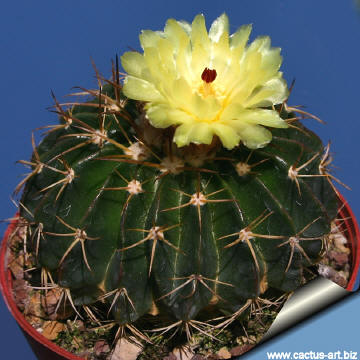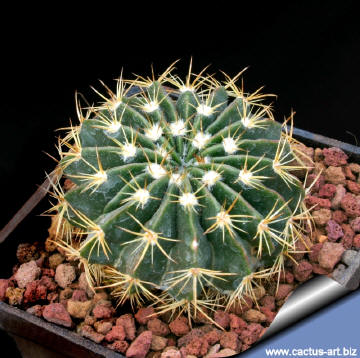|
|
|

Notocactus langsdorfii (polyacanthus)
FR1273
Arroio dos Ratos, Rio Grande do Sul, Brazil
This plant is recognizable for
numerous spines and the small-sized pale yellow flowers.
|
|
Description: Usually solitary (in the standard
form), or branching.
NOTE:
Notocactus langsdorfii,
together with the subordinated
taxa ('leprosorum', 'longispinum',
'pulvinatus', ediewarasii', 'multiceps' and
'prolifer'), form a group of
very similar and controversial southern Brasilian plants bearing small
flowers and strong spination.
Stem: Bright or dark green, globose to short cylindrical. The
apex is depressed and filled with whitish-grey wool.
Ribs: Well marked and sharp, with scarcely prominent chinned
tubercles. The crest of the ribs typically take on a purple red hue in
full sun.
Areoles: Well spaced, woolly, recessed .
Spines: Several, yellowish, strong, about 20-25 mm long, spreading
or curved down and backward.
Flowers: Small, lemon yellow with glossy shining petals, up to about
2-3 cm in diameter, standing near the top,
and decorated with a red pistil which emphasizes the yellow of the petals.
The buds are tomentose.
Blooming season: They bloom annually around June-July.
NOTE: All species of genera
Notocactus, Wigginsia and Malacocarpus
have recently been transferred to genus Parodia, so the
names of several plants previously accepted are now all synonyms of
Parodia langsdorfii.
|
|
 |
 |
|
The
flowers are lemon yellow with shining glossy petals,
and are very showy.
The red purple stigma emphasize the yellow of the petals.
|
|


Advertising
|
|
|
|
|
Family:
Cactaceae (Cactus
Family)
Conservation status:
Listed
in
CITES Appendix II
Accepted
Scientific name:
Notocactus
langsdorfii
(Lehmann) Krainz
In: Kakt. und
and. Sukk., 17: 195, 1966
Origin: Southern Brazil, Rio Grande do Sul, Brazil.
Habitat:
This species
usually grows between rocks.
Conservation status: Listed in
CITES appendix 2.
|
|
|
SUBORDINATES
TAXA:
Notocactus
langsdorfii
var. langsdorfii
Synonyms:
-
(Basionim)
Cactus (Melocactus) langsdorfii
Lehmann 1826
In: Semina in
Hort. bot. Hamburg. coll.: 17
-
Echinocactus
langsdorfii
(Lehmann) Link &
Otto
In: Icon. Pl.
Rar., p. 79, 1830
a
-
Echinocactus poliacanthus
Link
& Otto
In: Verh. Verh. Beförd. Gartenb., 3: 422, 1827
-
Cactus Langsdorfii
Lehmann 1828
in: Ind. Sem.
Hamburg., p. 17, 1826
-
Melocactus
langsdorfii
P. de Candolle
1828
-
Cactus poliacanthus
Link & Otto
1827
-
Malacocarpus polyacanthus
(Lk. et O.) Salm-Dyck
In: Cact. Hort.
Dyck., p. 25, 1841850
-
Malacocarpus langsdorfii
(Lehmann)
Britton & Rose
In: Cactaceae,
3: 1623, 1922
-
Notocactus
polyacanthus
(Link & Otto)
S.Theunissen
In: Succulenta,
60: 12, 1981
-
Melocactus polyacanthus
Lk. et O.
In: Verh. Verh. Beförd. Gartenb., tab. 16, 1827
-
Wigginsia langsdorfii
(Lehmann)
D.M.Porter
In: Taxon, 13:
210, 1964
-
Wigginsia polyacantha
(Link
& Otto) F.Ritter
In: Kakteen in
Südamerika, 1: 193, 1979
-
Parodia langsdorfii
D.R.Hunt 1997
-
Ritterocactus
langsdorfii
(Lehmann) Doweld
2000
Notocactus
langsdorfii var. leprosorum
(Ritter) Hofacker, 1994
Synonyms:
-
Wigginsia leprosorum
F.Ritter
1979
-
Notocactus leprosorum
(F.Ritter)
Havlicek 1981
-
Notocactus leprosorum
(F.Ritter)
S.Theunissen 1981
Notocactus langsdorfii
var.
longispinus
(F.Ritter )
N.Gerloff
In::
Internoto 14 (2): 78-79 1993
Synonyms:
-
(Basionym)
Wigginsia longispina
F.Ritter 1979
In: :
Kakteen in Suedamerika, Bd.1: 198-199 1979
-
Notocactus longispinus
(F.Ritter)
S.Theunisssen 1981
-
Notocactus
longispinus
(F.Ritter)
Havlicek 1981
-
Notocactus langsdorfii
var.
longispinus
f.
infernensis
n.n.
Notocactus langsdorfii var. pulvinatus
(van Vliet)
Neduchal, 1999
Notocactus langsdorfii
f. ediewarasii
N.Gerloff 1994
in: : Minimus 25
(2): 5-12 - 1994
Synonyms:
Notocactus
langsdorfii f. multiceps
(Hofacker et Herm) Neduchal, 1999
Notocactus langsdorfii
f.
prolifer
(F.Ritter )
N.Gerloff
In:
Internoto 14 (2): 76-77N.Gerloff 1993
Synonyms:
-
(Basionym)
Wigginsia prolifera
F.Ritter
In: Kakteen in
Suedamerika, Bd. 1: 199 1979
-
Notocactus prolifer
(F.Ritter)
S.Theunissen 1981
-
Notocactus prolifer
(F.Ritter)
Havlicek 1981
Cultivation:
It is easy to grow. They like a warm bright location, does great in
partial shade avoid full sun. They need good drainage and prefer a
neutral to slightly acidic compost with plenty of extra grit. Water and
feed during the summer. Best if watered with rain water. Keep above 0°C
and rather dry in winter, rot easily if the substrate is wet and cold,
tends to lose its roots in winter.
Propagation: Seeds
|
|